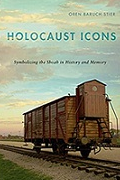Bio
My main area of interest is Holocaust Studies, and more generally Jewish Cultural Studies, with a special emphasis on the contemporary period and all aspects of present-day Jewish life and thought. My ongoing current research concerns Holocaust memory and representation: I've published two books on this topic: Committed to Memory: Cultural Mediations of the Holocaust (Amherst: University of Massachusetts Press, 2003), which addresses the roles the contemporary media and modes of cultural mediation play in shaping consciousness of the legacy of the Holocaust, especially in the form of its institutionalized memory, and Holocaust Icons: Symbolizing the Shoah in History and Memory (Rutgers University Press, 2015), which deals with the historical and memorial contexts of several fundamental images and ideas associated with the Holocaust. For this project I was on leave from January through August 2004 as a fellow at the Mandel Center for Advanced Holocaust Studies at the United States Holocaust Memorial Museum. Other ongoing research interests include Hasidism and South African Judaism, the latter growing out of my experiences living and teaching in Cape Town for three years from 1996-98. I also have an interest in Religion and Violence, and in 2006 I published a co-edited collection of essays on Religion, Violence, Memory, and Place (Indiana University Press). I have published academic journal articles in the Journal of the American Academy of Religion, Prooftexts, Jewish Social Studies, and Holocaust and Genocide Studies, and chapters in a number of edited collections. While I am responsible for teaching classes in all areas of Jewish Studies from the rabbinic period onwards, my current teaching leans toward the modern period: current courses include The Holocaust, Holocaust Memorials, Elie Wiesel, Holocaust Cinema, Jewish Mysticism, Judaism, Introduction to Jewish Cultures, Jews, Sex, and Gender, and, more generally, courses such as Violence and the Sacred and World Religions. I have taught in the greater Miami community as well, with lectures and adult education courses at local synagogues and at the Miami Art Museum. I also direct the Jewish Studies Certificate, and I am Director of the FIU Holocaust Studies Initiative, which sponsors lectures and funds the creation of online courses. I served as Graduate Program Director in the department of Religious Studies from 2007-2016.
Degrees
Ph.D. The University of California, Religious Studies 9/90-8/96Santa Barbara
M.A. The University of California, Religious Studies 9/88-6/90
Santa Barbara
A.B., with honors Princeton University Religion 9/84-6/88
Areas of Expertise
Director, Holocaust and Genocide Studies Program
Director, Jewish Studies Certificate Program
Selected Publications
Holocaust Icons: Symbolizing the Shoah in History and Memory
The Holocaust has bequeathed to contemporary society a cultural lexicon of intensely powerful symbols, a vocabulary of remembrance that we draw on to comprehend the otherwise incomprehensible horror of the Shoah. Engagingly written and illustrated with more than forty black-and-white images, Holocaust Icons probes the history and memory of four of these symbolic relics left in the Holocaust’s wake.
Jewish studies scholar Oren Stier offers in this volume new insight into symbols and the symbol-making process, as he traces the lives and afterlives of certain remnants of the Holocaust and their ongoing impact. Stier focuses in particular on four icons: the railway cars that carried Jews to their deaths, symbolizing the mechanics of murder; the Arbeit Macht Frei (“work makes you free”) sign over the entrance to Auschwitz, pointing to the insidious logic of the camp system; the number six million that represents an approximation of the number of Jews killed as well as mass murder more generally; and the persona of Anne Frank, associated with victimization. Stier shows how and why these icons—an object, a phrase, a number, and a person—have come to stand in for the Holocaust: where they came from and how they have been used and reproduced; how they are presently at risk from a variety of threats such as commodification; and what the future holds for the memory of the Shoah.
In illuminating these icons of the Holocaust, Stier offers valuable new perspective on one of the defining events of the twentieth century. He helps readers understand not only the Holocaust but also the profound nature of historical memory itself.

